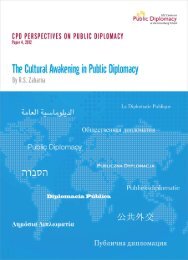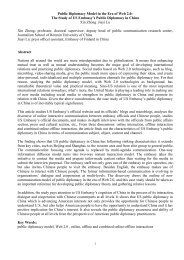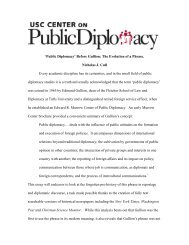Mapping the Great Beyond: Identifying Meaningful Networks in
Mapping the Great Beyond: Identifying Meaningful Networks in
Mapping the Great Beyond: Identifying Meaningful Networks in
You also want an ePaper? Increase the reach of your titles
YUMPU automatically turns print PDFs into web optimized ePapers that Google loves.
MAPPING THE GREAT BEYOND 63<br />
America.gov and Dipnote can be considered with<strong>in</strong> <strong>the</strong> negative<br />
and more colloquial use of periphery: largely unengaged with <strong>the</strong>se<br />
discussions between Twitter users.<br />
Simply micro-broadcast<strong>in</strong>g to a small group of followers is not<br />
enough. To be fully engaged <strong>in</strong> a conversation, an organization must<br />
consider <strong>the</strong> way o<strong>the</strong>rs engage <strong>in</strong> discussions of particular <strong>the</strong>mes<br />
and identify ways to <strong>in</strong>teract with <strong>the</strong>m. Ultimately, <strong>the</strong>se discussions<br />
will occur whe<strong>the</strong>r or not PD organizations engage <strong>in</strong> <strong>the</strong>m; at <strong>the</strong><br />
moment it is clear nei<strong>the</strong>r organization is go<strong>in</strong>g to have much impact<br />
on those conversations us<strong>in</strong>g <strong>the</strong>ir current approach.<br />
Conclusion from Case Study 2<br />
The benefit of mapp<strong>in</strong>g #tags is that it engages with <strong>the</strong> <strong>the</strong>mes<br />
which people are talk<strong>in</strong>g about. It seeks to understand <strong>the</strong> relationship<br />
between <strong>the</strong> organization and <strong>in</strong>dividuals discuss<strong>in</strong>g certa<strong>in</strong> key<br />
topics: whe<strong>the</strong>r <strong>the</strong>y are tak<strong>in</strong>g part <strong>in</strong> <strong>the</strong> same discussions; whe<strong>the</strong>r<br />
<strong>the</strong>y are engaged <strong>in</strong> more than one discussion; what topics users<br />
recognize as related; and whe<strong>the</strong>r organizations are hitt<strong>in</strong>g some<br />
key conversations and not o<strong>the</strong>rs. While success relat<strong>in</strong>g to behavior<br />
change may be difficult at this stage of analysis (although identify<strong>in</strong>g<br />
RT/Mentions may be one possibility, along with extensive analysis of<br />
tone), <strong>the</strong> first step <strong>in</strong> any <strong>in</strong>itiative must be to engage a community.<br />
<strong>Mapp<strong>in</strong>g</strong> #tags clearly demonstrates what is go<strong>in</strong>g on from a <strong>the</strong>matic<br />
perspective—similar methodology could be used for assess<strong>in</strong>g<br />
clusters for geographic location, with<strong>in</strong> constra<strong>in</strong>ts of <strong>the</strong> data.<br />
If Public Diplomacy is to fully engage with social media and<br />
Twitter <strong>in</strong> particular, a shift <strong>in</strong> operational m<strong>in</strong>dset from broadcast to<br />
engagement with networks cluster<strong>in</strong>g around <strong>the</strong>mes and ideas will<br />
be central to deliver<strong>in</strong>g successful <strong>in</strong>itiatives.











